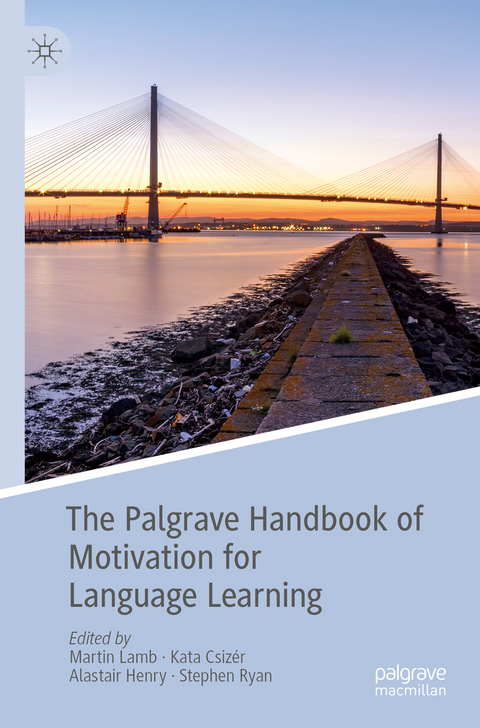
The Palgrave Handbook of Motivation for Language Learning
Springer International Publishing (Verlag)
978-3-030-28382-7 (ISBN)
This handbook offers an authoritative, one-stop reference work for the dynamic and expanding field of language learning motivation. The 32 chapters have been specially commissioned from the field's most influential researchers and writers. Together they present a compelling picture of the motivations people have for learning languages, the diverse ways we can research motivation, and the implications for promoting and sustaining learners' motivation. The first section outlines the main theoretical approaches to language learning motivation; the next section presents ways in which motivation theory has been applied in practice; the third section showcases examples of motivation research in particular contexts and with particular types of language learners; and the final section describes the exciting directions that contemporary research is taking, promising important new insights for academics and practitioners alike.
lt;p>Martin Lamb is Senior Lecturer in TESOL at the University of Leeds, UK. He previously worked as a language teacher and trainer in Sweden, Indonesia, Saudi Arabia and Bulgaria. His main research interest is in language learner motivation and how it interacts with features of context like teaching in school.
Kata Csizér is Associate Professor and Chair of the Department of English and Applied Linguistics at Eötvös University, Hungary. Her main field of research interest is the social psychological aspects of L2 learning and teaching, as well as second and foreign language motivation.
Alastair Henry is Professor of Language Education at University West, Sweden. His research involves the psychology of language learning and teaching. In addition to motivation, his work has focused on teacher identities and language choices in contexts of migration.
Stephen Ryan is Professor of Applied Linguistics in the School of Culture, Media and Society at Waseda University, Japan. His research covers various aspects of psychology in language learning, and he has several co-authored books in the field.
Part I. Theoretical approaches to L2 motivation.- Chapter 1: Introduction (Martin Lamb, Kata Csizér, Alastair Henry and Stephen Ryan).- Chapter 2: L2 Motivation and the Socio-Educational Model (Robert Gardner).- Chapter 3: From Integrative Motivation to Directed Motivational Currents: the Evolution of Understanding L2 Motivation Over 3 Decades (Zoltan Dörnyei).- Chapter 4: The L2 Motivational Self-System (Kata Csizér).- Chapter 5: Self-Determination and Motivated Engagement in Language Learning (Kimberly A. Noels, Nigel Mantou Lou, Dayuma I. Vargas Lascano, Kathryn E. Chaffee, Ali Dincer, Ying Shan, Doris Zhang and Xijia Zhang).- Chapter 6: Complexity Theory and L2 Motivation (Phil Hiver and Mostafa Papi).- Chapter 7: Directed Motivational Currents: Extending the Theory of L2 Vision (Alastair Henry).- Chapter 8: Motivation and Individual Differences (Stephen Ryan).- Chapter 9: Emotions Are Motivating (Peter D. MacIntyre, Jessica Ross and Richard Clément).- Chapter 10: L2 Motivation and Willingness to Communicate (Tomoko Yashima).- Chapter 11: The Contexts of SLA Motivation: Linking Ideologies to Situational Variations (Odilia Yim, Richard Clément and Peter MacIntyre).- Chapter 12: L2 Motivation and Investment (Ron Darvin).- Part 2: L2 Motivation in Practice.- Chapter 13: Task Motivation (Judit Kormos and James Wilby).- Chapter 14: Motivational Teaching Strategies (Martin Lamb).- Chapter 15: Motivational Group Dynamics in SLA: the Interpersonal Interaction Imperative (Yoshifumi Fukada, Joseph Falout, Tetsuya Fukuda and Tim Murphey).- Chapter 16: Motivation and Projects (Christine Muir).- Chapter 17: Motivation in Content and Language Integrated Learning (CLIL) Research (David Lasagabaster).- Chapter 18: The Process of Demotivation in Language Learning: An Integrative Account (Nick Thorner and Keita Kikuchi).- Chapter 19: Language Teacher Motivation Research: Its Ends, Means and Future Commitments (Maggie Kubanyiova).- Part 3: Contexts of L2 Motivation.- Chapter 20: EFL Learning Motivation in Korea: Historical Background and Current Situation (Tae-Young Kim and Youngmi Kim).- Chapter 21: In the Shadow of Global English? Comparing Language Learner Motivation in Germany and the United Kingdom (Ursula Lanvers and Gary Chambers).- Chapter 22: Motivation for Learning Chinese in the Australian Context: Focus on Tertiary Students (Hui Ling Xu and Robyn Moloney).- Chapter 23: Motivation and Multilingualism in South Africa (Susan Coetzee and Van Roy).- Chapter 24: The L2 Motivation of Learners with Special Educational Needs (Edit Kontra).- Chapter 25: Motivation of Young Language Learners (Jelena Mihaljevic Djigunovic and Marianne Nikolov).- Part 4: Shifting Horizons in L2 Motivation.- Chapter 26: Language Mindsets, Meaning-Making, and Motivation (Nigel Mantou Lou and Kim Noels).- Chapter 27: Motivation and the Unconscious (Ali Al-Hoorie).- Chapter 28: Motivation and Flow (Katalin Piniel and Agnes Albert).- Chapter 29: L2 Motivation and Digital Technologies (Alastair Henry and Martin Lamb).- Chapter 30: Aligning Positive Psychology with Language Learning Motivation (Tammy Gregersen).- Chapter 31: Motivation for Formal Learning of Multiple Languages (Amy Thompson).- Chapter 32: Researching L2 Motivation: Past, Present and Future (Ema Ushioda).
"The combination of theory and practice in this volume contributes to expanding its readership. Experts as well as novice researchers of L2 motivation will benefit from this arrangement, as the former have a deep understanding of L2 motivation but can learn about new areas, and the latter can attain insight on the topic. As a comprehensive and practical conclusion of current L2 motivation research, this volume will guide researchers to further probe into L2 motivation." (Lixiang Gao & Honggang Liu, Revista Española de Lingüística Aplicada, Vol. 34 (2), 2021)
“The combination of theory and practice in this volume contributes to expanding its readership. Experts as well as novice researchers of L2 motivation will benefit from this arrangement, as the former have a deep understanding of L2 motivation but can learn about new areas, and the latter can attain insight on the topic. As a comprehensive and practical conclusion of current L2 motivation research, this volume will guide researchers to further probe into L2 motivation.” (Lixiang Gao & Honggang Liu, Revista Española de Lingüística Aplicada, Vol. 34 (2), 2021)
| Erscheinungsdatum | 26.01.2021 |
|---|---|
| Zusatzinfo | XXIX, 697 p. 15 illus. |
| Verlagsort | Cham |
| Sprache | englisch |
| Maße | 155 x 235 mm |
| Gewicht | 1098 g |
| Themenwelt | Schulbuch / Wörterbuch ► Wörterbuch / Fremdsprachen |
| Geisteswissenschaften ► Psychologie ► Pädagogische Psychologie | |
| Geisteswissenschaften ► Sprach- / Literaturwissenschaft ► Sprachwissenschaft | |
| Sozialwissenschaften ► Pädagogik ► Schulpädagogik / Grundschule | |
| Schlagworte | Classroom dynamics • Communication • Content and Language Integrated Learning • Demotivation • Emotions • L2 • Learning and Instruction • Multilingualism • Pluralingualism • positive psychology • Resilience • Self-Determination Theory • Sign Language • Socio-educational model • Teaching Strategies • Technology |
| ISBN-10 | 3-030-28382-8 / 3030283828 |
| ISBN-13 | 978-3-030-28382-7 / 9783030283827 |
| Zustand | Neuware |
| Haben Sie eine Frage zum Produkt? |
aus dem Bereich


